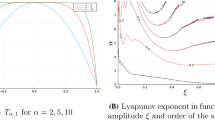Abstract
We apply standard projection operator techniques known from nonequilibrium statistical mechanics to eliminate fast chaotic degrees of freedom in a low-dimensional dynamical system. Through the usual perturbative approach we end up in second order with a stochastic system where the fast chaotic degrees of freedom are modelled by Gaussian white noise. The accuracy of the perturbation expansion is analysed in detail by the discussion of an exactly solvable model.
Similar content being viewed by others
REFERENCES
N. G. van Kampen, Elimination of fast variables, Phys. Rep. 124:69(1985).
M. C. Cross and P. C. Hohenberg, Pattern formation outside of equilibrium, Rev. Mod. Phys. 65:851(1993).
H. Haken, Synergetics (Springer, Berlin, 1977).
J. Guckenheimer and P. Holmes, Nonlinear Oscillations, Dynamical Systems, and Bifurcations of Vector Fields (Springer, New York, 1986).
C. Jones, Geometric singular perturbation theory, in Dynamical Systems, R. Johnson, ed. (Springer, Berlin, 1995).
A. Sanders and F. Verhulst, Averaging Methods in Nonlinear Dynamical Systems (Springer, New York, 1985).
K. Hasselmann, Stochastic climate models: Part I. Theory, Tellus 28:473(1976).
M. I. Freidlin and A. D. Wentzell, Random Perturbations of Dynamical Systems (Springer, New York, 1998).
R. Z. Khasminskij, A limit theorem for the solutions of differential equations with random right-hand sides, Theory Probab. Appl. 11:390(1966).
M. Suzuki, Statistical mechanics of non-equilibrium systems. II, Progr. Theoret. Phys. 55:383(1976).
C. Beck, From the Perron-Frobenius equation to the Fokker-Planck equation, J. Stat. Phys. 79:875(1995).
W. Just, H. Kantz, C. Rödenbeck, and M. Helm, Stochastic modelling: Replacing fast degrees of freedom by noise, J. Phys. A 34:3199(2001).
R. Zwanzig, Ensemble method in the theory of irreversibility, J. Chem. Phys. 33:1338(1960).
H. Mori, H. Fujisaka, and H. Shigematsu, A new expansion of the master equation, Progr. Theoret. Phys. 51:109(1974).
K. Gelfert, Asymptotic behaviour of multi time-scale systems via Young measure limits, preprint (2002).
H. Risken, The Fokker-Planck Equation: Methods of Solution and Applications (Springer, Berlin, 1989).
P. Grigolini, L. A. Lugiato, R. Mannella, P. V. E. McClintock, M. Merri, and M. Pernigo, Fokker-Planck description of stochastic processes with colored noise, Phys. Rev. A 38:1966(1988).
O. Hald and R. Kupferman, Existence of orthogonal dynamics, preprint (2002).
Author information
Authors and Affiliations
Rights and permissions
About this article
Cite this article
Just, W., Gelfert, K., Baba, N. et al. Elimination of Fast Chaotic Degrees of Freedom: On the Accuracy of the Born Approximation. Journal of Statistical Physics 112, 277–292 (2003). https://doi.org/10.1023/A:1023635805818
Issue Date:
DOI: https://doi.org/10.1023/A:1023635805818




